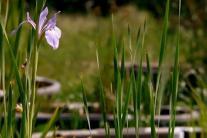The University of Louisiana at Lafayette has taken its place in the top level of the nation’s research institutions
Ecology Center offers seedlings at PlantFest
Tue, 09/17/2013 - 9:34amStaff members from the University of Louisiana at Lafayette’s Ecology Center are helping to preserve plants native to the coastal prairie. For the first time ever, they are offering some of those plants for sale. The Ecology Center will have a sales tent at PlantFest, which will be held at the Horse Farm on Saturday, beginning at 8 a.m.
Their effort to cultivate native varieties, which began in 2007 with a handful of seeds, has expanded to about five acres that contain 40 species, including grasses and flowering plants.
“These plants are a valuable resource,” said Dr. Susan Mopper, a University biology professor who is also director of the Center. The native prairie once covered more than nine million acres in Louisiana and Texas. But because of agricultural practices and urban sprawl, less than 0.1 percent remains.
Seeds from adapted plants germinate easily. And once the perennial plants are established, they require very little care, including minimal watering. The plants’ extensive root systems can reduce soil erosion and improve water quality.
“In addition, many of the plants are very beautiful, so they’re ideal for urban landscaping,” Mopper added.
Seeds of native species are available commercially, but because they are grown in other parts of the country, they are not adapted to local conditions. The Center is conducting research on its native plants to develop its line of specialized PureNative™ seed mixes that will be suitable for a variety of applications.
For example, grasses are especially appealing to farmers and ranchers because they require little or no maintenance and provide nutritious grazing food for livestock. Some of the plants are very attractive to bees and butterflies, insects that pollinate crops.

